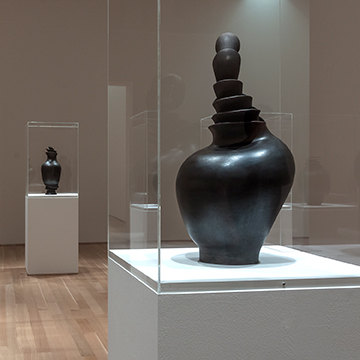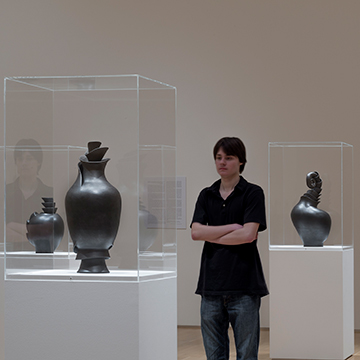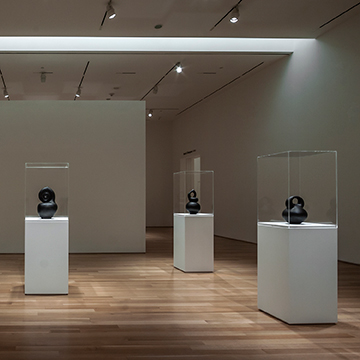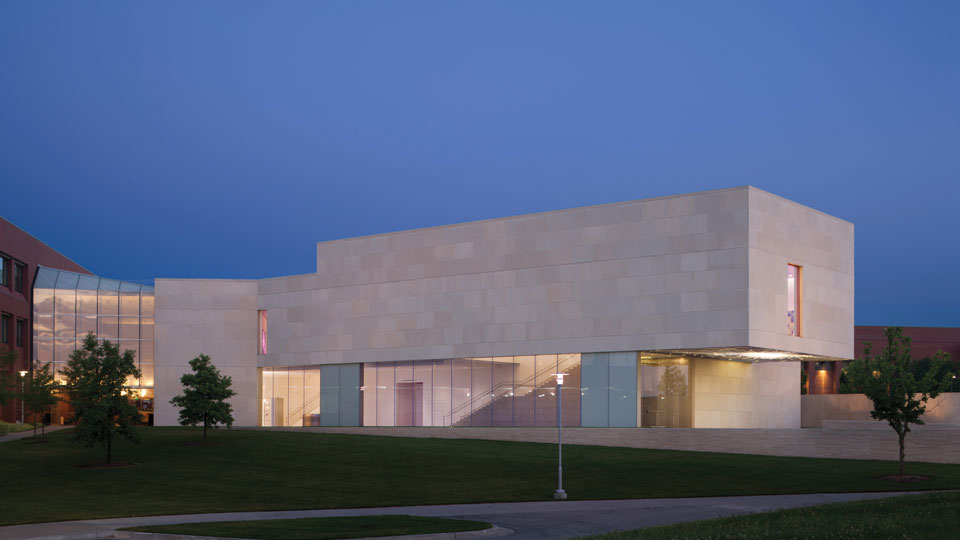Dark Light · the Ceramics of Christine Nofchissey McHorse
Christine McHorse is considered one of the most innovative forces in American Indian ceramics today, creating vessel-based works, which are unadorned and abstract and that resonate more with modern sculpture than with traditional Southwestern pottery. This exhibition addresses McHorse’s journey as an artist, focusing upon works from her Dark Light series from 1997 to the present.
McHorse was born in Morenci, Arizona in 1948. Her parents, both Navajo, were from the last generation to be forced into an assimilation program that attempted to destroy Native culture, language, art, customs and religion. Children were removed from their homes and family, by force if necessary, and taken to boarding schools. As a consequence, her parents never returned to the Navajo reservation, preferring to live and work in the town of Morenci – best known for its’ massive Phelps Dodge Morenci Mine.
In 1963, as a high school sophomore, McHorse’s sisters, Arlene and Alberta, convinced their parents to allow fourteen-year-old Christine to join them at the Institute of American Indian Arts (IAIA) in Santa Fe, NM. McHorse remembers an institution that then “was more a refuge than a school. Many of us were using the school to escape, rather than looking for an education. My sisters brought me there because life in an Arizona mining town was dangerous, ugly, violent, culturally barren and a place where alcoholism was endemic.”
It was at IAIA that she met her future husband, Joel McHorse, a Taos Indian and fellow art student. Joel had entered the school at age fifteen. He too joined to avoid a self-destructive trajectory that he saw his life taking if he remained in Taos.
Christine McHorse was introduced to “shiny earth,” or micaceous pottery, by her Taos Pueblo mother-in-law, Lena Archuleta. Taos potters, like those of the neighboring Picuris, Nambe and Teseque Pueblos (nestled in the foothills and passes of New Mexico’s Sangre de Cristo mountains), have been making micaceous pottery for over 700 years. The clay of this region is naturally rich in mica particles (metamorphic rock subjected to high pressures and temperatures). When utilized in pottery making, and after coiling, burnishing and firing, the mica flecks create a glittering surface upon which light dances back and forth.
At first, McHorse’s pots reflected the traditional shapes of Pueblo cooking vessels, but as a Navajo, McHorse was not under cultural pressure to make vessels reflective of Taos pottery traditions. Her work evolved as a mixture of Taos, Navajo and contemporary influences.
McHorse’s micaceous clay vessels introduce an element of muscular architectonics and formal complexity to the realm of indigenous southwestern ceramics. Her deep, warm black surfaces shimmer with chatoyance of mica, while her radical, curvilinear clay constructs owe as much to the baroque, Brancusi and Barbara Hepworth as they do to ancient regional forms.
McHorse believes that clay was in her destiny from the outset. The San Francisco River ran south out of the canyon past her parent’s house, providing her with one of her most tenacious childhood memories, “Once a year, overnight, the muffled song of the water changed to a deafening roar as the spring rains brought swollen muddy waters and we’d stand alongside our neighbors, as close to the river as we dared, as it demonstrated its awesome power. Wet, cold and shivering, we’d watch the bobbing logs and spinning driftwood race by. We stared as the banks plunged into turbulence. I distinctly remember the damp earth smell as the river changed its course again and again. It was the smell of clay.”





